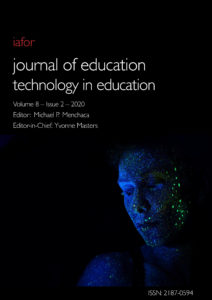Welcome to the IAFOR Journal of Education’s inaugural Technology in Education issue. While the Journal structure may be slightly altered at times, our commitment to interdisciplinary, international, intercultural, quality manuscripts remains. As editor, I rely heavily on an extensive group including the editor-in-chief, two associate editors, and an incredible team of reviewers. I am truly humbled by everyone’s dedication, hard work, and support, especially given the challenges brought on by the global pandemic. Given current circumstances, technology becomes even more significant in facilitating collaboration in the world. Although IAFOR has reserved a special topic issue for manuscripts specifically related to the impact of COVID-19, technology, particularly in education, plays an important role in our collective progress.
 The scope of Technology in Education is purposefully broad to ensure the greatest representation of contemporary knowledge impacting all learning, formal and informal. The journal’s simple aim to improve education requires broad representation in scope and extensive comprehension in depth. To achieve such depth, one factor binds all published manuscripts, firm theoretical foundations. As editor, my one piece of advice to prospective authors: connect your study to sound theoretical or conceptual foundations.
The scope of Technology in Education is purposefully broad to ensure the greatest representation of contemporary knowledge impacting all learning, formal and informal. The journal’s simple aim to improve education requires broad representation in scope and extensive comprehension in depth. To achieve such depth, one factor binds all published manuscripts, firm theoretical foundations. As editor, my one piece of advice to prospective authors: connect your study to sound theoretical or conceptual foundations.
Reflecting IAFOR’s commitment to diverse knowledge and international collaboration, the nine published studies encompass:
- Five continents: Asia, Europe, Africa, North America, and Oceania;
- Seven countries: Malaysia, the Philippines, Turkey, Rwanda, the United States, Mexico, and Papua New Guinea;
- Three studies focusing on open education: MOOCs; Open Educational Resources; and Open Textbooks;
- Three studies focusing on online learning: learning management systems; online journalism; and a virtual language exchange;
- Three studies focusing on general e-learning: informal language learning through digital media; digital annotations; and digital literacy.
Please find below a brief summary of each article.
Article 1
In the first article, Ruhil Amal Azmuddin, Nor Fariza Mohd Nor, and Afendi Hamat employ qualitative focus group and content analysis methods to investigate how digital annotation tools facilitate reading comprehension. Their “Facilitating Online Reading Comprehension in Enhanced Learning Environment Using Digital Annotation Tools” article examines how Malaysian students in a public university rely on digital annotation tools to assist in their overall reading comprehension. Their research suggests that students will benefit from training on how to approach annotation tasks in online environments.
https://doi.org/10.22492/ije.8.2.01
Article 2
Runchana Pam Barger, in her article, “Democratization of Education through Massive Open Online Courses in Asia,” uses content analysis to examine the promise of Open Education to democratize education in Asia. The study indicates that while MOOCs can promote social and economic mobility, barriers, such as language, culture, and lack of digital literacy and technical knowledge, prevent underserved populations in particular from successfully pursuing a digital education. Collaboration between governments, corporations, non-government organizations, and local communities is needed to provide the infrastructure and support necessary to promote more equitable opportunities for learning.
https://doi.org/10.22492/ije.8.2.02
Article 3
The third article, “Understanding the Characteristics of English Language Learners’ Out-of-Class Language Learning through Digital Practices,” by Ali Dincer, draws on mixed-methods to look at students’ use of digital tools outside the classroom for English language learning at three state universities in Turkey. The study identifies the importance for teachers to link classroom teaching to outside digital tools such as social media, games, YouTube, and intelligent tutoring applications.
https://doi.org/10.22492/ije.8.2.03
Article 4
Ariana Eichelberger and Hong Ngo, in “Beyond the Basics: Adapting an Open Textbook to Accommodate a Flipped Class,” utilize a mixed-methods approach to determine how undergraduate Biology students at a public university in Hawaii perceive an Open Biology textbook, including identification of design features, course satisfaction, and suggestions for improvement. Design decisions made based on conceptual frameworks as well as student feedback improved the text and the students’ overall experience.
https://doi.org/10.22492/ije.8.2.04
Article 5
In “Learning Management Systems Adoption in Higher Education Using the Extended Technology Acceptance Model,” Marissa R. Fearnley and Johnny T. Amora employ structural equation modeling to determine the influence of technology acceptance constructs among teachers in using a Learning Management System at a private college in the Philippines. Significant implications of the study include the importance of self-confidence and system quality in technology adoption.
https://doi.org/10.22492/ije.8.2.05
Article 6
In the sixth article, Iwona Kolodziejczyk, Philip Gibbs, Cecilia Nembou, and Maria Rodina Sagrista conduct regression analysis in a study of the level of digital skills among university students in Papua New Guinea. Their study, “Digital Skills at Divine Word University, Papua New Guinea,” suggests that operational and formal skills are necessary, but not sufficient, for higher information skills. Compared to countries such as the Netherlands, the effects of the digital divide mean first year students in Papua New Guinea are at a disadvantage and face a steep learning curve in attaining digital literacy, thus needing exposure to digital skills much sooner.
https://doi.org/10.22492/ije.8.2.06
Article 7
Chesla Ann Lenkaitis, Shannon M. Hilliker, and Kayla Roumeliotis, through qualitative analysis, examine the effects of a virtual exchange among teacher training candidates learning to teach English to Speakers of Other Languages in their article, “Teacher Candidate Reflection and Development Through Virtual Exchange.” Teacher candidates at a U.S. university partnered with English as a Foreign Language learners at a Mexican university to assist in language learning. The study supports direct language collaboration through virtual exchange as a contributor to teacher candidate success.
https://doi.org/10.22492/ije.8.2.07
Article 8
The eighth article, “Training Factors as Predictors of Students’ Self-Efficacy Beliefs for Online Journalism Practice,” authored by Joseph Njuguna, employs correlation analysis to determine the strength between training factors and students’ self-efficacy in five Rwandan universities. The results show the importance of training in fostering students’ beliefs and confidence in their capacity to perform online.
https://doi.org/10.22492/ije.8.2.08
Article 9
In the final article, “Developing an Open Educational Resource and Exploring OER-enabled Pedagogy in Higher Education,” Beth Tillinghast relies on an interpretive qualitative approach to explore the perspectives of staff and faculty developing an Open Textbook using OER-enabled Pedagogy in a public university in the United States. Constructs including attitude, performance expectancy, and facilitating conditions are found to be of critical importance in OER development. Further, the study recommends a team approach to OER development.
https://doi.org/10.22492/ije.8.2.09
I hope you enjoy reading these articles as much as I enjoyed reviewing them.
Michael P. Menchaca
tech.editor.joe@iafor.org
Editor, IAFOR Journal of Education: Technology in Education

